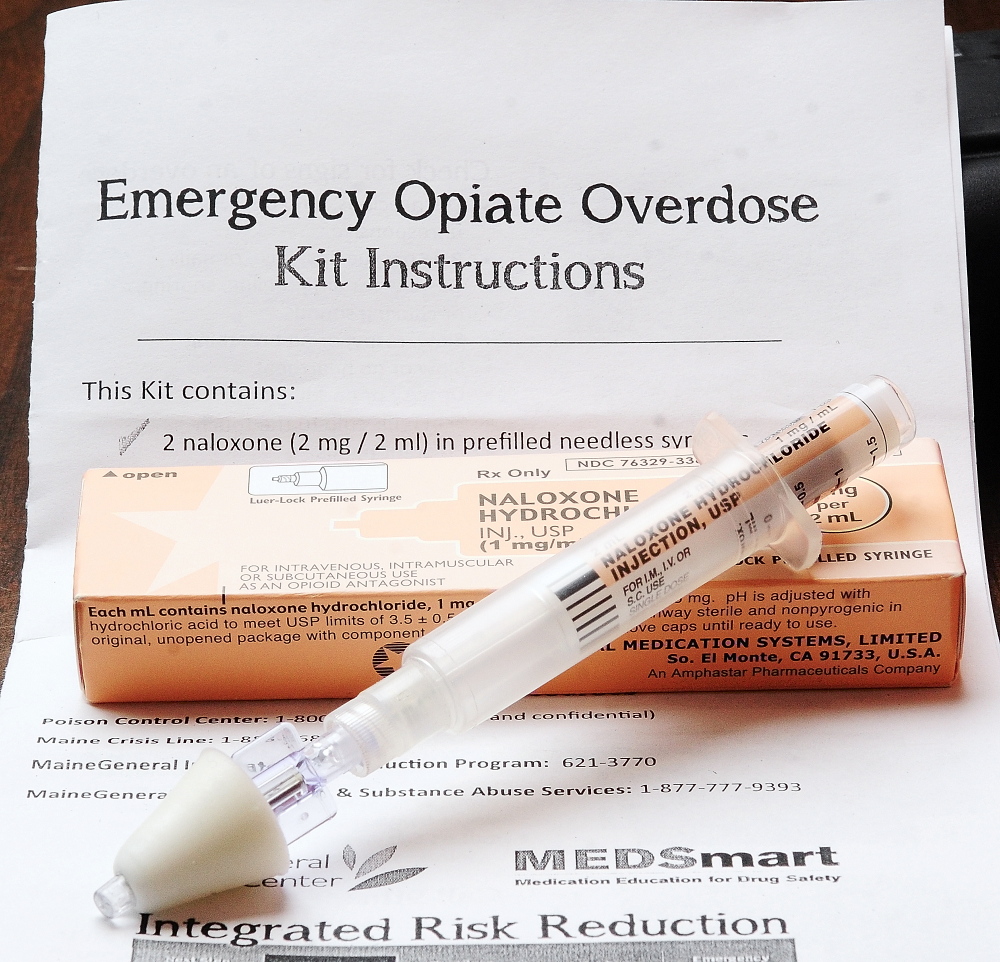The group that regulates Maine pharmacies is asking state lawmakers to revisit a law that was passed last spring with the goal of allowing over-the-counter sales of naloxone, a drug that reverses the effects of an opiate overdose and that can’t be sold to individuals now without permission from a physician.
At the same time, supporters of the law are relieved the Maine Board of Pharmacy finally has begun discussing the rules, but some are frustrated it has taken so long.
Passed in late April, the law directed the Board of Pharmacy to approve rules for pharmacists hoping to sell naloxone, commonly known by its brand name Narcan. It gave the board until July 1, 2017, to create the rules.
In late September, several city and statewide health groups co-signed a letter asking board members to begin the work during their November meeting and referring them to Massachusetts rules that could serve as a model. On Thursday, during the Board of Pharmacy’s December meeting, members finally began discussing the legislation, which was meant to help limit the damage from the state’s ongoing opiate crisis.
“It’s certainly about time,” said Kenney Miller, a co-signer of the September letter and executive director of the Health Equity Alliance, a statewide harm reduction organization with offices in Augusta, Bangor, Ellsworth and Machias. “It’s months after the (legislative) session ended. In the meantime, we’ve seen report after report of overdose death rates continuing to climb. … The longer we delay on this, the more people we lose; and we’re breaking records again, as far as overdose death rates as concerned.”
It’s still an open question whether the Board of Pharmacy will implement quickly the rules outlined in the naloxone law passed last April.
When the group met last week, several staff and board members said they were confused about the law’s intentions and wanted clarification from the lawmakers who sponsored it. Board members raised several questions, including whether pharmacists could have a right to refuse to sell naloxone, whether they would have to administer naloxone to customers and whether there should be age limits on who can buy it.
But the most confusing part of the law, according to pharmacy board President Joe Bruno and others, is a sentence in the bill that seems to contradict the stated goals of its authors.
The sponsors of the law, L.D. 1547, hoped it would allow pharmacists to sell naloxone without a prescription, making it more accessible to drug addicts and those who might be in a position to save them. When they proposed the legislation, they pointed to the growing numbers of Mainers who overdose from heroin and prescription painkillers every year.
During the first nine months of 2016, drug overdose deaths surpassed the total for all of 2015, according to statistics released last month by the state attorney general’s office. Mainers have died in record numbers, with 286 fatalities tallied through Sept. 30.
“We should take any opportunity to counteract the deadly impacts of addiction while we work to put more and better prevention, treatment and enforcement strategies into place,” the bill’s co-sponsor, Rep. Sara Gideon, said in committee testimony last February. “Providing naloxone over the counter is one such opportunity. Simply put, it saves lives. We can increase the availability of naloxone in a safe and measured way through pharmaceutical dispensation without a prescription.”
The law earned support from public health groups, police officers, physicians, harm reduction advocates and recovered drug users, among others. Gov Paul LePage vetoed the bill — arguing that naloxone only “perpetuates the cycle of addiction” — but lawmakers overrode his veto with a 132-14 vote in the House and a 29-5 vote in the Senate.
Naloxone can be used as either an injection or nasal spray. According to Bruno — a pharmacist who serves as president and chief executive officer of the Augusta-based Community Pharmacies — a nasal spray dose costs about $50 at the retail level, while injections are more expensive.
It has become a regular tool among Maine’s firefighters, emergency medical technicians and even some police officers, who are often the first to respond to a reported drug overdose. There has also been a push to get Naloxone into the hands of drug users themselves and private citizens in a position to help them, through laws such as L.D. 1547.
But members of the Board of Pharmacy were confused about whether the language of L.D. 1547 actually legally directed them to create rules for Maine pharmacists to sell the drug over the counter.
The governor appoints the Board of Pharmacy’s seven members, all but two of whom are licensed pharmacists. Their tasks include licensing individual pharmacists, considering different prescribing rules and disciplining those who have broken rules.
One sentence in the law directs the Board of Pharmacy to “establish procedures and standards for authorizing pharmacists to dispense” naloxone.
If the law had ended there, it clearly would have allowed the Board of Pharmacy to create rules for pharmacies to sell naloxone over the counter, said the board’s attorney, Assistant Attorney General Andrew Black, who was at the Thursday meeting.
But the next sentence confused several board members, as well as Black. It directs the board to establish “training requirements and protocols” for pharmacists to dispense naloxone “by prescription drug order or standing order or pursuant to a collaborative practice agreement.”
According to Bruno, Maine pharmacists already can dispense naloxone when a physician has allowed it, whether through a prescription, a standing order or a collaborative practice agreement. All three are administrative ways for physicians to authorize a drug’s distribution.
“We don’t know legislative intent,” Bruno said. “It’s a poorly written bill, personally. It looks like it was cut and pasted from some other state. I don’t know if the intent of the sponsor was you walk in a pharmacy just like you would a flu shot, the pharmacist goes, ‘OK, here’s your information, and after I talk to you, here’s your naloxone.’ I don’t know if that was the intent, but that’s not what this does. All this reiterates is what a pharmacist can already do.”
“There’s nothing this law does that we couldn’t do a year ago,” Bruno — a former state representative who served two terms as House Republican leader — said later.
At the end of the meeting, the board members instructed Geraldine Betts, an administrator, to begin drafting the law; but Bruno said he would ask Gideon, a co-sponsor of the bill, to submit emergency legislation in the upcoming session that clarifies the intentions of the law.
Gideon, a Freeport woman whom Democrats have nominated to serve as speaker of the Maine House of Representatives, did not respond to requests for comment by Friday afternoon.
After the meeting, Bruno said he doesn’t know what will happen with the rulemaking process if the lawmakers are unable to get additional legislation passed.
Those who supported the law, meanwhile, have urged the Board of Pharmacy to complete the rulemaking as soon as possible. In addition to Miller, other co-signers of the letter in September included Gordon Smith, executive vice president of the Maine Medical Association, which represents about 70 percent of the state’s practicing physicians, and the directors of public health services in Bangor and Portland.
Bruno said the Board of Pharmacy took several months to begin the rulemaking on L.D. 1547 because it had “other things” to do, but declined to comment on how the group prioritizes its tasks, other than to say that “the major role of any board is to protect the public. That’s where our priorities lie.”
He emphasized that the group has until July 1 to complete the rulemaking.
“By not making a decision today, it’s still available with prescription, so we’re not preventing people from getting protected,” said another board member, Shane Savage.
During the Thursday meeting, Bruno said he does not think there is market demand for naloxone at the moment. He added that there are nonprofit groups — such as Miller’s — that already hand out naloxone to drug users, even though there are no clear rules allowing them to do so.
Miller said his own organization distributes naloxone kits in “a legal gray area” because state health officials have been slow to establish protocols for another law approved in Maine, L.D. 140, that helped create community-based naloxone distribution programs. But he disagreed with the assertions that there is no demand for the sale of naloxone in pharmacies.
He said demand for a product could be hard to predict until it’s on the shelf, adding that friends or family members of drug users might be more willing to obtain the drug in a pharmacy than by going to a homeless shelter or a needle exchange. Miller also said it can be quite hard for some drug users to walk into a doctor’s office and ask for a prescription for an overdose-reversing drug.
“Many people either don’t have access to health care in that way or they’re not willing or able to engage with doctors around drug use,” he said. But laws such as L.D. 140 and L.D. 1547, he continued, “are solutions to this problem, or at least a partial solution to this problem, a way to sustain lives that are now being taken with the seriousness they deserve.”
Charles Eichacker — 621-5642
Twitter: @ceichacker
Copy the Story LinkSend questions/comments to the editors.





Success. Please wait for the page to reload. If the page does not reload within 5 seconds, please refresh the page.
Enter your email and password to access comments.
Hi, to comment on stories you must . This profile is in addition to your subscription and website login.
Already have a commenting profile? .
Invalid username/password.
Please check your email to confirm and complete your registration.
Only subscribers are eligible to post comments. Please subscribe or login first for digital access. Here’s why.
Use the form below to reset your password. When you've submitted your account email, we will send an email with a reset code.